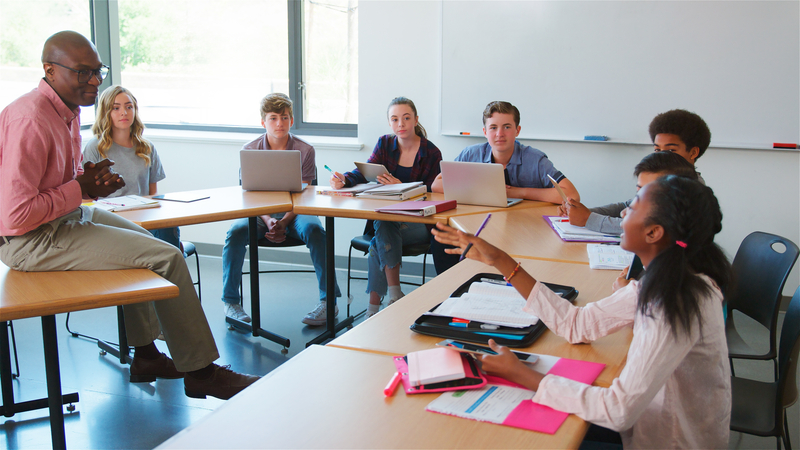November 1, 2020
•
5 min (est.)•
Vol. 62•
No. 115 Components of Blended Learning
To foster students' investment in a unit, capture their attention from the start.
Blended learning (also known as hybrid learning) is an educational approach that combines face-to-face instruction with some form of online engagement. It can be daunting to determine how best to navigate these different delivery modes to design cohesive learning experiences. Structuring lessons according to the following five components—and determining which component is best suited to which setting—can help streamline the planning process.
To foster students' investment in a unit, capture their attention from the start. Potential hooks include introducing novelty, a connection, a puzzle or challenge, or a chance for students to make predictions (Doubet & Hockett, 2015).
Face-to-Face: Make a connection between students and content. A 3rd grade teacher introduced a geography unit with the essential question, "What causes change over time?" Students' answers about themselves, their families, and their communities launched an investigation of the same question regarding geographical change.
Ask for predictions. Students in a 5th grade science class examined a partial data set on the time students spend playing video games in a week and made predictions before seeing the entire data set and graphing the results.
Online: Try novelty. Relevant video clips, memes, or comics are useful online launchpads. An English teacher began a study on the effect of a narrator's perspective by posting several optical illusions with varied interpretations and asking students to comment explaining what they saw.
Offer a puzzle or challenge. As an introduction to ratios, middle school math teacher Brett Johnson posted pictures of Ant Man and The Hulk and challenged students to compare their sizes using a can of soda as a reference point.
Instruction can be delivered face-to-face or online (synchronously or asynchronously). Whether live or recorded, be sure to (1) model skills and ask students to give them a try, and (2) chunk content to avoid overwhelming students with too much at once. After each chunk, build in time for students to process the material.
Face-to-Face: Build in spots to "prompt and pause," allowing students to answer questions, share examples, and use response cards.
Online: Provide direct instruction via video and be sure to include opportunities to "pause and post" along the way for students to share "a-ha" moments, questions, and examples.
Align formative assessment with clear learning goals to monitor student progress toward those goals. Chunk goals as you do content and formatively assess after each chunk. Administer ongoing checks for understanding to individuals, pairs, or small groups to determine what's making sense to students, what's confusing them, or where they have misconceptions. Review these student results to determine the nature of follow-up tasks.
Face-to-Face: Capitalize on face-to-face time by administering group checks for understanding using whiteboards, think-pair-shares, discussion, and debate to reveal shared understandings and misconceptions. Ending class with a traditional exit slip helps shape subsequent instruction to more accurately meet student needs.
Online: Use digital platforms to monitor student understanding during online learning. Students learning about different triangles might draw examples on GoFormative or post pictures of examples on Padlet. These online learning checks reveal if reteaching is needed, streamlining instructional time.
Provide students with the opportunity to practice skills—or apply them to a new context—in the company of peers. At their best, processing tasks will engage students with learning goals and with one another.
Face-to-Face: Students can collaborate in traditional small groups or via individual devices using Google Docs or Slides. These forums also allow groups to present their work to the full class by sharing links or projecting products on the classroom screen. Use face-to-face time to provide explicit instruction based on student needs revealed by students' collaborative work.
Online: Engage students in meaningful online interactions with peers through discussion posts in your school's learning management system or on sites like Flipgrid. Invite interaction by asking classmates to comment on one another's posts. Students can also use Google Docs or Slides to maintain the flow of collaborative work between digital and face-to-face settings.
It's important to provide motivating tasks that invite students into learning. Unlike isolated drills, such tasks can easily transition between school and home if they are grounded in authentic connections to the real world (e.g., investigating real-world issues, solving problems set in real-world contexts, using skills and tools of professionals) or to students' personal lives (pursuing areas of personal interest or relevance) (McTighe, Doubet, & Carbaugh, 2020).
Face-to-Face: Introduce tasks in face-to-face or remote, synchronous settings so that students have opportunities to ask questions. If you plan to use digital tools like Piktochart, Canva, or Anchor, introduce those in class so that students can experiment and become comfortable while you are there to troubleshoot.
Online: Continuing work online is most successful when students have access to peers for collaboration (through Google Docs or chats) and have a place to post questions that surface during work. Take advantage of flexible online learning experiences by scheduling opportunities for students to interact with mentors (in the community or beyond).








